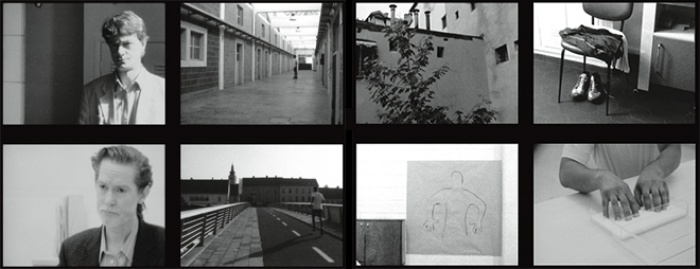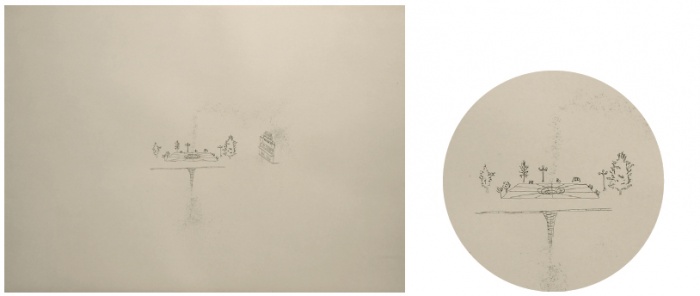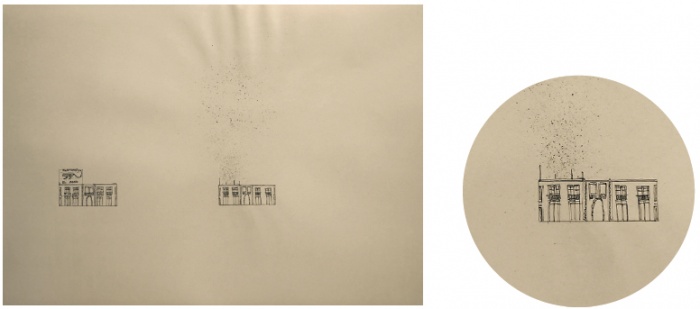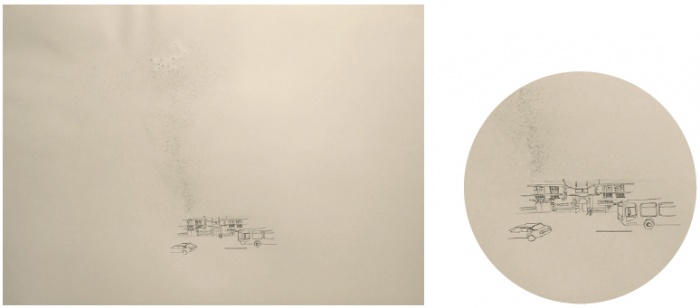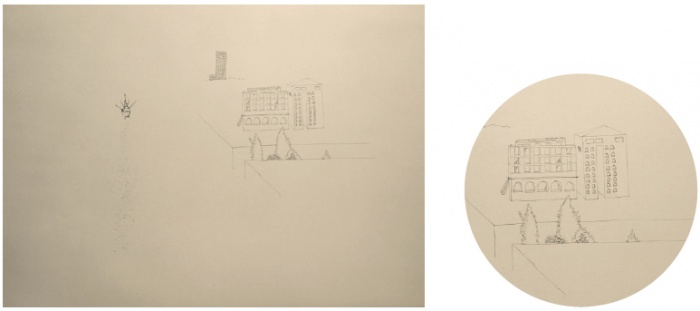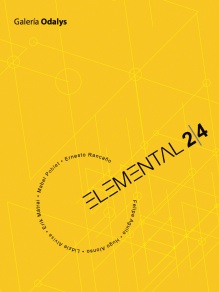Elemental 2|4
Katja Jedermann
ELEMENTAL II/IV unites in one exhibition works of four male and two female artists, the oldest 46 and the youngest 28 years old, born in Cuba, Chile, Spain and Hungary, some of them well travelled.
Memory is the subject all artists deal with in very diferent ways. Being a ‘Berlinerin’ (since birth) and of a different (older) generation, I must admit, that I face the work of these – for me - younger artists with a certain inhibition, as they dispose of a completely different background of experiences, which to explore will prove to be only partly successful. When I look at their work, I try not to refer my first associations and memories to works of artists like Rebecca Horn, Valie Export, Gerhard Richter or Christian Boltanski, so I may keep my curiosity and will not fall into the well known euro-centered trap.
I will not make any such comparisons, although you probably might assume, that the young artists are well versed in the art world, dispose of all visual information and relate – consciously or unconsciously – to the repertoire of art history.
“Present time art defines its present no longer by delimitation from a closed past, rather establishes its present through manifold relationships with a past which is recognized and treated as something that continues to affect the present”. 1
In the works united in this exhibition the theme memory is less related to political or biographical facts, nor is collecting, storing or archiving the main interest, but rather the transience and the recognition and reappearance of images, which have been accumulated in the subconscious. Images, which mostly derive from the media, images, which evoke emotions and remind of sentiments, which have been engraved into the body and which return to the level of consciousness through the works of art.
The Cuban artist Ernesto Rancaño understands memory as the construction of identities of individuals. His work, in this case installations with transparent materials, which somehow uncover what human consciousness tries to hide, make the invisible visible, which then still remains hidden. Artful machines of forgetting and remembering, which as in “Detained drawing”, collect the graphite dust, which represents the tracks of a drawing not be observed.
Also the turned-over plate of the installation “Forgetting” covers and hides the meal that is being served on this transparent shining table. It remains the secret of the artist, which history is being told by the minimalistic metallic furniture; the central European observer might be allowed to arrive at associations to the history of modernity, to de Stijl and Bauhaus, although she might be thoroughly wrong.
The third work in the exhibition “The rich man” explores the richness of human life, which is represented here by an assorted collection of somewhat worn small photos. The transparent installation acts like a metaphor of the human brain, which in the course of life stores innumerable memories of encounters and relations with other people…
In his work “Insist” the artist shows a sequence of the same male face, which through increasing lighting is made to disappear slowly. The text written on its forehead “I only exist, when you see me” refers to the dependence of human existence from the counterpart. Or with the words of Sartre: “The Other has a secret (…) of what I am.” 2
The works of Ernesto Rancaño receive their life from the tension between their formal minimalism and their emotional charge in addressing existential themes.
In this sense there exists a connection to the youngest (female) artist of the exhibition, the Cuban Mabel Poblet Pujol. In her work “High Tide” from the series “Fatherland” she has addressed a current issue which is virulent, not only in Cuba. The escape across the sea that separates poor and rich countries, the desperation, fear, and death, but also hope and dreams of the people who assume the deadly risk because they do not see any alternative for their life. By tackling these conflicting sentiments and the tragic life stories, since ever related to the sea - at the borders of countries and continents – the artist refers to one of the most important world problems, for which until now there has been no solution because of the rigid immigration legislation of the rich countries. Mabel Poblet mounts this big theme in a strictly formal installation. What at first glance at its 2x3 m frame seems to be a decorative, lively sparkling wall treatment, reveals at close observation the manifold hopeful and tragic aspects of the sea and thus elevates the theme to a more general level of perception, which reaches beyond daily politics.
The projects second female artist, Lidzie Alvisa, also Cuban, belongs to the generation of Ernesto Rancaño. In her installation “Estados” (States, conditions) she uses daily objects from our digitalized lives through which to transmit the ‘heart beat’ of our time. In “File state” she recreates the waves of enlarged electrocardiograms by using Hi8, miniDVs or diskettes, CDs and DVDs. They not only inform about the short life span of the storage media used by us, but also make us reflect about the way how personal memories, thoughts about past and future relate to the digital archives, which we all keep, hoping to be able to dispose about the past by objective means in the future. In another work of the series “Estados” the lines of the waves of the ECG are being retraced by using last generation mobile phones, which already generate nostalgic sentiments in the age of the smart phone. At the same time, these devices are tied to us personally and able to inform about our condition at any time of the day or night. As the ECG, they are able to document the condition (estado) of our heart.
With the work “A nivel” (Leveled) our gaze is view returned onto itself. Two laser spirit levels project a line, which hits the view of the author, presented in a photograph of her eyes in a three-wall installation. With this installation, Lidzie Alvisa reflects the level of the view, its expanse or limitation, the horizon, which determines our perception. It remains open what determines limit and orientation. The technical construction of the laser beam offers many interpretations.
The Hungarian artist Erik Mátrai confronts us with experiments of perception of quite a different kind.
In contrast to his earlier works, mostly consisting of light installations with fog effects, in his works in the present exhibition light and color are produced in two-dimensional panel paintings. The aim of the artist is here to surmount the materiality of painting: the acrylic color is de-materialized and the geometric forms are brought into a state of floating, which makes them appear like a memory of light events. These are works aiming at transcendence and which stimulate the observer to meditation.
With projections of a quite a different sort deals the young Spanish artist Hugo Alonso in his acrylic paintings. Here memories of key scenes out of horror movies appear from the unconscious like dream images of sinister spaces and situations. Thereby the artist achieves to treat these movie ‘stills’ in a way, that the deeply rooted memory of their vagueness becomes visible, evoking at the same time their original menace.
With his appropriation of movie images, which by now well belong to the international collective memory, Alonso adds another facet to the love affair between movie and art, as stated by Heinz-Peter Schwerfel 3.
The Chilean artist Felipe Aguila also is referring to movie history, in his film “Apolide”, when he shows a man without memory and without affiliation running through the every day’s urban life, in search of his identity, which through multiple shreds of memories repeatedly comes to the surface. There are indications of clinic and public offices, which should give to the self-searching references about his existence through inquiries and measurements.
The black and white movie, with its mixture of long dream (nightmare) like sequences and short scenes with abrupt cuts places itself quite consciously in the tradition of the surrealistic movie.
“The movie is a wonderful and dangerous weapon, when it is handled by a free spirit. It is the best instrument, to express the world of dreams, of emotions of instincts. The creative mechanism of the filmed images is among all human means of expression the one that most resembles the functioning of the human mind, it is the one that best imitates the working of the mind in dreams.” 4
In his small drawings, looking lost placed on the large paper formats, and which challenge the visitor to the most precise observation, Felipe Aguila connects parts of buildings or stage drops, which seem to float in a hinted urban space with catastrophes, events, abysses and shallows, which lead the existing urban order ad absurdum. Here also combine memory, dream and reality in a poetic way.
In the interaction of the six different artistic approaches the visitor receives a diverse image of the confrontation with his/her own existence, which tries to assure itself through different forms of remembering. The recourse to the available reservoir of images becomes as visible as the search for a personal, reflected, experienced physically and psychically position, whose coordinates are determined less by the art world than by the own life situation.
1. Juliane Rebentisch, Theories of Contemporary Art, Hamburg, 2013, p. 120
2. Jean-Paul Sartre, Being and Nothingness, Reinbek 1974, p. 467
3. Heinz-Peter Schwerfel, Cinema and Art. A Love Story, Cologne, 2003
4. Luis Buñuel: The spots of the Giraffe, Berlin 1991. p. 144
Orfila 5, 28010, Madrid. Spain
September 18th 2014 to November 13th 2014


